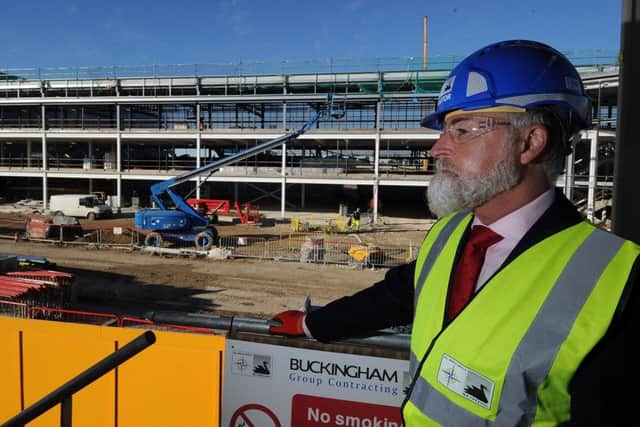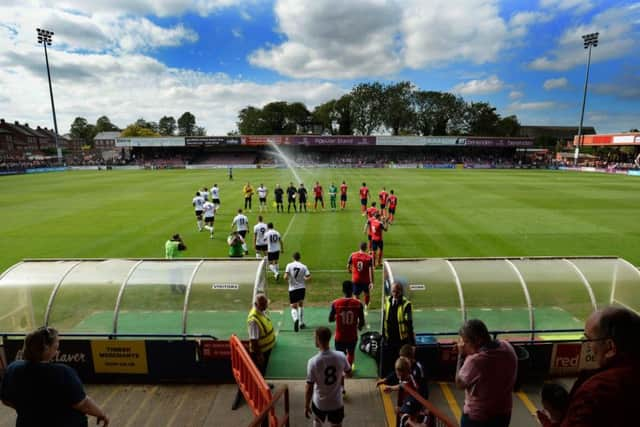Why switch to new home secures York City's future
The Minstermen are due to move into the new 8,000-capacity Community Stadium at Monks Cross – which will also house York City Knights rugby league club – next summer.
Work began last December and is firmly on schedule with all four stands set to be completed early in the new year.
Advertisement
Hide AdAdvertisement
Hide AdYork being handed the keys to their new home will bring to an end a long-running saga featuring interminable delays that, at various stages, threatened to derail a £64m project that also includes a 13-screen cinema, health centre, swimming pool and retail park.


“The club couldn’t have carried on forever at Bootham Crescent,” said the 52-year-old after giving The Yorkshire Post an exclusive tour of a venue that is being partly built on top of the old Huntington Stadium, which closed in 2014.
“York City loses money there and has done for sometime. Of course it will be a wrench to leave. Bootham Crescent has been our home since 1932 and has some fantastic memories for all of us, good and bad. But by moving here we are safeguarding the club’s future.
“The original plan was to be in here by 2011. For a lot of reasons that didn’t happen. None to do with the football club, I hasten to add.
Advertisement
Hide AdAdvertisement
Hide Ad“Now, though, as you look around at this magnificent facility going up you can see we are entering a new period in the club’s history. The club is protected by an agreement we have with the Council for 99 years. It means there can be no repeat of what happened in the past.”


York’s route to Monks Cross began unwittingly in 1999 via their home being transferred from the club to Bootham Crescent Holdings, a company set up by then board members Douglas Craig, Colin Webb and Barry Swallow.
The ground was bought back via a £2m loan from the Football Stadia Improvement Fund (FSIF) five years later when McGill and the Supporters Trust were jointly in charge. The loan was made on the proviso that a new stadium be completed within seven years, after which the £2m would be converted into a grant that will be the football club’s contribution to the new stadium.
An agreement was also reached with Persimmon Homes, who had previously struck a deal with Bootham Crescent Holdings for the 4.4 acre site. The company was also granted first refusal on buying Bootham Crescent at a 10 per cent discount of its market value.
Advertisement
Hide AdAdvertisement
Hide Ad“The FSIF have been fantastic throughout,” said McGill, who assumed a majority 75 per cent shareholding in 2006 in return for providing £1m in funding to take York through to the new stadium’s scheduled opening date of 2011.
“If they hadn’t provided the £2m loan then York City would have folded and probably had to start again somewhere else. Maybe even here at the old rugby stadium (Huntington), though the facilities would have been way below League standard.
“Without that lifeline Bootham Crescent could have been sold. The Council probably wouldn’t have given permission to build on the site while York City were still in operation.
“But who in their right mind was going to keep a club going and also put in what was needed with nothing on the horizon?”
Advertisement
Hide AdAdvertisement
Hide AdAfter the initial 2011 target date had been missed several other deadlines came and went to leave many in the city wondering if the stadium would ever be built.
McGill added: “The FSIF could have been ruthless and said, ‘There is no sign of this being built, no matter what the Council say, and we want our £2m back’.
“I didn’t have £2m to give them. So we would have had to sell Bootham Crescent and give them the £2m back. We owe the FSIF a lot.”
A price is still to be agreed with Persimmon for Bootham Crescent as the countdown continues to the May 14 handover date.
Advertisement
Hide AdAdvertisement
Hide AdThe equity left from the sale after other creditors’ claims have been met will then be used to cover the loans McGill has made to the club on an interest-free basis to bridge the gap until the move.
With these outlays including £2m to the Council, £400,000 interest to FSIF and around £200,000 to the shareholders of Bootham Crescent Holdings, chances are McGill will end up out of pocket.
“I would say I have contributed around £4.5m net,” added McGill. “If I had left in 2011 as planned with the new stadium open that would have been it. Even a delay to 2012 when we won promotion to the Football League or 2014 when we reached the League Two play-offs under Nigel Worthington would have been fine.
“Then I could have walked away having delivered on my original pledge of York City getting a new stadium along with promotion back to the League.
“But things did not work out as planned and now, with Persimmon having a 10 per cent discount, the sale is unlikely to cover what I have contributed.”
Dawn of a new era: Page 20.